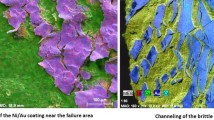Abstract
A ceramic substrate bonded to an electronic sensor was reported to crack during thermal testing between −46 and +71 °C. Initially, this was assumed to occur at high temperature because of the thermal expansion of a polymer pad under the sensor. However, further investigations indicated that fracture was also occurring at low temperature. This was surprising since the suspected cause of fracture was pressure exerted by the polymer pad under the ceramic. This polymer pad has a coefficient of thermal expansion much greater than any other component. Conventional wisdom suggests that this failure would happen only during expansion of the pad during high temperature phases of temperature cycling. Subsequent dynamic thermal analysis revealed that differential contraction of the steel clamp fasteners was causing pressure to be exerted on the ceramic during the initial phase of the cold cycle. In addition, lateral constraint of the polymer pad caused pressure to rise to counterintuitive levels. An alteration of the geometry of the pad proved to be the simplest and most economical solution. This was confirmed by subsequent testing.





Similar content being viewed by others
Author information
Authors and Affiliations
Corresponding author
Rights and permissions
About this article
Cite this article
Blanco, L., Taylor, S. & Wiggins, K. Unexpected Thermal Fracture of a Ceramic Sensor. J Fail. Anal. and Preven. 11, 478–480 (2011). https://doi.org/10.1007/s11668-011-9483-7
Received:
Published:
Issue Date:
DOI: https://doi.org/10.1007/s11668-011-9483-7




